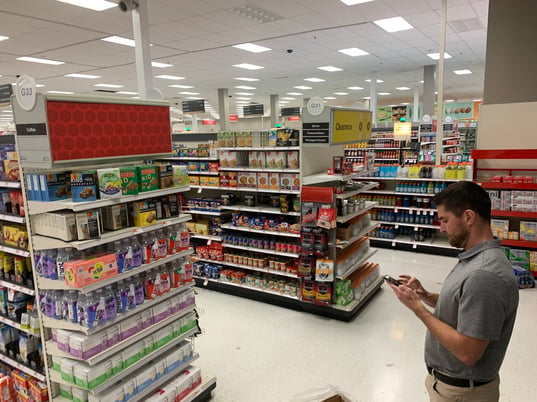It is normal to be confused when it comes to understanding the difference between point of purchase (POP) and point of sale (POS). Not only do they sound really similar, but they actually do have a lot of similarities.
POP, or point of purchase, refers to the physical location where consumers decide whether or not to buy a product. POS, or point of sale, refers to the specific area where the exchange of goods takes place. For example, the point of purchase for a loaf of bread is a grocery store, while the point of sale is the check-out aisle at the cash register.

In this article, we will go into detail about these differences and explain how they fit into a brand’s sales strategy.
POP Definition
When we say POP refers to points of in-store interaction between customer and product, we are talking about shelf facings, specialized POP displays, and promotional material. Again, the point of purchase is where a buyer is considering purchasing a product, which precedes their actual decision as they head to the checkout counter.
While the point of purchase includes facings on a home shelf, brands often associate POP with POP displays, which are targeted standalone displays that exist separately from a brand’s traditional aisle SKUs. These displays usually occupy floor space throughout a retailer in the form of dump bins, standing displays, or clip strips. The main reason brands incorporate POP displays in their sales strategies is to increase the number of facings and their product’s presence in the store.
In addition to displays, we have POP promotional materials. These also occupy floor space in a store or could even exist on windows or walls. They usually take the form of signage and are a great way to raise awareness about promotions, new products, or specialty packaging.
POS Definition
POS refers solely to the customer-product interactions that occur where the actual sale of the product happens. Typically these interactions take place near the checkout area of a retailer.
POS displays are just as common as POP displays and serve a similar purpose: to draw the shopper’s attention to your product. The difference is that these displays will reside in or near a register. Think to your local grocery store and the cooler displays at the end of the checkout, the magazine racks next to the counter, and the confectionary displays you pass by as you complete your purchase. POS displays are great for pushing products that shoppers are likely to impulse buy rather than a planned purchase.
It is worth noting that POS can also refer to a POS system, which is the technology and software a retailer uses to process sales. The most obvious example of this is the card reader at the cash register.
The Role of POP Displays in a Sales Strategy
Now that we have established the difference between POP and POS, you may be asking yourself, “what does this mean for me and my sales strategy?”
POP displays are a fantastic way to insert your products directly into a shopper’s path in-store. By adding facings apart from the traditional aisle shelf, shoppers are much more likely to choose your product over a competitor’s.
POP Display Strengths:
-
Larger products or quantities of products
-
Products already on a customer’s shopping list
-
Temporary promotions or sales
-
Pushing different packaging options (think about a six pack of bottled beverages vs. a single bottle)
-
Raising brand awareness
-
Versatility and mobility of a display
The Role of POS Displays in a Sales Strategy
Because of the location of POS displays, there are a few variations with when and why a brand might utilize them. POS displays sometimes may be a product’s only facings in a store, whereas POP displays are almost always secondary to a product’s primary placement.
POS Display Strengths:
The major benefit of POS displays is that their location almost guarantees that shoppers will encounter your product during their shopping trip since every shopper ends up at the checkout counter. This is why they are optimal for products that probably don’t make it onto a potential buyer’s shopping list but that upon encountering them, may trigger a spontaneous purchase — think candy bars, bottled soft drinks, and small cosmetic products like lip balm.
Brands can also use POS displays for pushing promotions such as BOGO or special packaging in the same way they use POP displays. Smaller specialized displays that can rest on the counter can incorporate signage to draw the shopper’s attention.
POP and POS Best Practices
To round out all of the information provided above, here are some key takeaways to remember when distinguishing between point of purchase and point of sale:
-
POP stands for “point-of-purchase” and refers to anything that customers interact with in-store when they are deciding whether or not to purchase a product.
-
POS stands for “point-of-sale” and refers to the actual transaction that occurs when the customer buys the product.
-
Both POP and POS displays function to draw attention to your product and to any promotions or sales that you are running.
-
POP displays are almost always secondary facings to the facings a brand occupies on its home shelf.
-
POS displays may be secondary or primary facings for a brand.
-
POP displays usually take up floor space within the retailer, while POS displays are smaller and take up space near or on the checkout counter.



.png?width=480&height=252&name=PRESS%20RELEASE-2%20(4).png)

